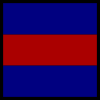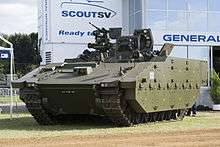Household Cavalry Regiment
| The Household Cavalry Regiment | |
|---|---|
 | |
| Active | 19 October 1992 – present |
| Country | United Kingdom |
| Branch |
|
| Role | Armoured Cavalry Regiment |
| Part of | Household Cavalry |
| Garrison/HQ | Combermere Barracks, Windsor |
| Motto(s) |
Honi Soit Qui Mal Y Pense (Evil be to Him who Evil Thinks) |
| March |
Life Guards: Quick – Millanollo Slow – Life Guards Slow March Trot past – Keel Row Blues and Royals: Quick – Quick March of the Blues and Royals Slow – Slow March of the Blues and Royals Trot past – Keel Row |
| Equipment | Combat Vehicle Reconnaissance Tracked |
| Commanders | |
| Commanding Officer | Lt Colonel Ed Hayward MBE |
| Colonel-in-Chief | HM The Queen |
| Insignia | |
| Tactical Recognition Flash |
 |
The Household Cavalry Regiment (HCR) is an Armoured Cavalry regiment of the British Army based at Combermere Barracks in Windsor. It is the brother regiment of the Household Cavalry Mounted Regiment (HCMR) based at Hyde Park Barracks in London - both regiments together form the Household Cavalry. The Household Cavalry was formed in 1992, under the Options for Change reforms, by the union of The Life Guards and the Blues and Royals in order to preserve the distinct identities of the regiments. A precedent for the Household Cavalry Regiment has previously been set by the Household Cavalry Composite Regiment - active during the Anglo-Egyptian War, the Second Boer War and latterly during both the First and Second World Wars.
The HCR is part of the Household Cavalry, rather than the Royal Armoured Corps (RAC), which encompasses all other armoured and cavalry regiments of the British Army. It serves as the 1st Armoured Infantry Brigade's Formation Reconnaissance regiment and hence is equipped with the Combat Vehicle Reconnaissance (Tracked) family of vehicles, including the Scimitar, and is considered, for operational purposes, as part of the RAC.
History
The Household Cavalry Regiment was established as part of the Options for Change defence review in 1992.[1]
Former Yugoslavia
The House Cavalry Regiment's squadrons served in the Yugoslav Wars on rotations over a nine-year period. Deployments to the Former Republic of Yugoslavia included tours by A and D Squadrons in 1995[2] and C Squadron in 1999[3] and 2003.[4][5] They were largely based at Banja Luka, headquarters of the Multi-National Division (South-West), for which the British Armed Forces were responsible. In 1997 two squadrons from the regiment were awarded the Wilkinson Sword of Peace for their work in "returning the lives of members of the severely damaged community of Banja Luka to conditions approaching normality, in which the seeds of long-standing peace might grow."[6]
Fire Brigades Union strike
In 2002, Household Cavalry Regiment soldiers crewed fire appliances during the Fire Brigades Union strike.[7] In 2003, exceptionally, the regiment was tasked at short notice to provide additional armed security at Heathrow Airport, in response to a specific threat.[8]
Iraq
D Squadron deployed in their function as the Formation Reconnaissance Squadron for 16 Air Assault Brigade during the 2003 invasion of Iraq.[9] The squadron led the brigade main body into Iraq before conducting a wide range of tasks, including around the Rumalayah oil fields. The squadron was unfortunate to be involved in a friendly-fire incident involving a US A-10 Thunderbolt. Lance Corporal of Horse Matty Hull was killed in the incident.[10] In a separate incident, Lieutenant Alex Tweedie and Lance Corporal Karl Shearer died when the Scimitar over-turned into an irrigation canal.[11] The squadron received various decorations for its service: Trooper Chris Finney was awarded the George Cross for his actions during the A-10 incident,[12] Major Richard Taylor received the Distinguished Service Order,[13] Corporal of Horse John Flynn received the Conspicuous Gallantry Cross for his actions in a battle with Iraqi armour,[14] and Corporal of Horse Glynn Bell was awarded the Military Cross for his actions shortly before the end of the tour.[15] In April 2004, A and C Squadrons deployed during Operation Telic 4 and in June 2007, A and C Squadrons again returned to Iraq during Operation Telic 10.[9]
Afghanistan
During Operation Herrick 4, D Squadron deployed as the Formation Reconnaissance Squadron for 1st Mechanised Brigade in April 2006.[9] C Squadron deployed with 52nd Infantry Brigade during Operation Herrick 7 in October 2007 and saw action at the Battle of Musa Qala to recover the town of Musa Qala from the Taliban.[9] D Squadron again deployed with 16 Air Assault Brigade, initially around Musa Qala, then east of Girishk during Operation Herrick 7 in April 2008.[9] One squadron deployed with 11th Light Brigade during Operation Herrick 11 in October 2009 and, finally, one squadron deployed with 1st Mechanised Brigade Operation Herrick 18 in April 2013.[9]
Recent deployments
The Household Cavalry Regiment contributed to security at the London Olympic Games in 2012 and flood relief in the local area during 2014.[16]

Role
Armoured Cavalry - successor role to Brigade Reconnaissance Regiment
In 2014, the Household Cavalry Regiment was re-designated from a Brigade Reconnaissance Regiment to Armoured Cavalry as part of the Army 2020 reforms.[17] The Household Cavalry Regiment's task is to provide timely and accurate information and intelligence to the Brigade Commander in order to enable decision-making. To fulfil this function, the Household Cavalry Regiment conducts surveillance and reconnaissance activities, mounted or dismounted, in all weathers by day or night. The regiment's vehicles enable information-gathering to be conducted whilst mobile, at pace, and whilst under fire. The change in designation from Brigade Reconnaissance Regiment to Armoured Cavalry reflects the evolving role of the Household Cavalry Regiment in preparation for Scout SV. The arrival of Scout will bring with it the capacity to operate in a far bolder and more offensive way than has been possible with CVR(T). The Household Cavalry Regiment is under the command of 1 Armoured Infantry Brigade, based at Tidworth Camp in Wiltshire.[18]
Structure
The regiment is structured as follows:[19]
- Regimental Headquarters
- Recce squadrons (three)
- Command and support squadron
Equipment

- Combat Vehicle Reconnaissance (Tracked): The Household Cavalry Regiment, like the other Armoured Cavalry Regiments, continues to be equipped with the Combat Vehicle Reconnaissance (Tracked) series of vehicles, first employed in the 1970s.[20]
- Scout SV: In due course, the Household Cavalry Regiment will convert to Ajax (Scout SV) - the British Army's first new Armoured Fighting Vehicle platform in a generation. Ajax will replace a number of CVR(T) variants, particularly Scimitar.[21]
- Sighting and Surveillance Systems: A range of surveillance equipment is used by the Household Cavalry Regiment to fulfil its intelligence-gathering mission. Javelin Command and Launch Units (CLUs) and sniper sights provide additional dismounted surveillance systems. Surveillance Troop is equipped with additional specialised equipment, specific to its role.[22]
- Communications Equipment: The regiment uses PRC-152 radios for ground-to-air communications.[23]
- Weapons Systems: The Household Cavalry employs a variety of weapons systems, providing a range of capabilities including, notably, the L115A3 Long Range Rifle.[24]
The Household Cavalry Foundation
The Household Cavalry is supported by the Household Cavalry Foundation, the regimental charity, which raises funds in aid of five core themes: casualties, veterans, serving soldiers, horses and heritage.[25]
The Household Cavalry Regiment Museum

The Household Cavalry has two museums. The Household Cavalry museum is located at Horse Guards Parade in central London, where the HCMR mounts the Queen's Life Guard. The museum is a very popular tourist attraction with digital audio guides in several languages. The museum includes a window into the working stables of the Queen's Life Guard, allowing visitors to watch ongoing care of the horses throughout the day. Separately, the Household Cavalry Regiment has its own museum at Combermere Barracks in Windsor. A volunteer team organise tours and events and, in particular, administer the regiment's extensive material, documentary and photographic archives. The museum is open to public groups, by appointment.[26]
See also
References
- ↑ "Regimental History". Household Cavalry Foundation. Retrieved 31 July 2016.
- ↑ Watson, Fiona M.; Dodd, Tom (1 May 1995). Bosnia and Croatia: the conflict continues Research Paper 95/55. House of Commons Library International Affairs and Defence Section.
- ↑ "QRF on guard". NATO (SFOR). Retrieved 31 July 2016.
- ↑ "Deployments". Parliamentary Debates (Hansard). House of Commons. 21 March 2005. col. 570W.
- ↑ "British Army in Bosnia-Herzegovina, November-December 2003". Imperial War Museum. Retrieved 31 July 2016.
- ↑ "Wilkinson Sword of Peace". Parliamentary Debates (Hansard). House of Commons. 17 January 2000. col. 277W.
- ↑ "No time for tea for the troops on the front line". The Telegraph. 24 November 2002. Retrieved 1 July 2015.
- ↑ "In pictures: Army patrols Heathrow". BBC. 11 February 2003. Retrieved 1 July 2015.
- 1 2 3 4 5 6 "Household Cavalry Regiment". British Army units 1945 on. Retrieved 31 July 2016.
- ↑ "American pilot on 'friendly fire' video named". The Telegraph. 8 February 2007. Retrieved 31 July 2016.
- ↑ "Soldier died when tank overturned". BBC. 24 January 2007. Retrieved 31 July 2016.
- ↑ "Trooper who saved friend in face of friendly fire awarded George Cross". The Guardian. 31 October 2003. Retrieved 31 July 2016.
- ↑ "Iraq war soldiers awarded medals". BBC. 9 December 2004. Retrieved 31 July 2016.
- ↑ The London Gazette: (Supplement) no. 57100. p. 4. 21 October 2003. Retrieved 12 February 2010.
- ↑ "Operational honoursand awards". Ministry of Defence. 23 April 2004. Retrieved 31 July 2016.
- ↑ "Duke of Cambridge hauls sandbags in flood-hit village while Duchess opens art studio". The Telegraph. 14 February 2014. Retrieved 1 July 2015.
- ↑ "Army 2020 - British Army Website". Ministry of Defence. Retrieved 29 June 2015.
- ↑ "Transforming the British Army - an update" (PDF). Ministry of Defence. July 2013. Retrieved 31 July 2016.
- ↑ "Household Cavalry and Royal Armoured Corps". Armed Forces. Retrieved 31 July 2016.
- ↑ "The Household Cavalry Regiment (HCR)". Ministry of Defence. Retrieved 31 July 2016.
- ↑ "Scout SV named Ajax". Janes. 16 September 2015. Retrieved 31 July 2016.
- ↑ "Household Cavalry: our offer". Ministry of Defence. Retrieved 31 July 2016.
- ↑ "Prince Harry determined to return to front line". The Telegraph. 29 February 2008. Retrieved 31 July 2016. (Picture shows Prince Harry with PRC-152 radio)
- ↑ "Sales Of L115-A3 Sniper Rifles Soar". Daily Mash. 10 May 2010. Retrieved 31 July 2016.
- ↑ "Household Cavalry Foundation". www.hcavfoundation.org. Retrieved 30 June 2015.
- ↑ "Household Cavalry Museum". www.householdcavalrymuseum.co.uk. Retrieved 30 June 2015.